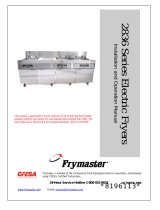
5. Allow the breaded pieces to fall onto a tray as they come
out of the breader drum. (More breading may be needed
if a large amount of product is to be breaded.)
6. If a breading machine is not used, the food should be placed
in the dry mix and hand tumbled so that each piece of food
is completely covered.
7. Knock off any excess breading and place the breaded
product on a tray for cooler storage. Place a damp cloth
over the breaded food to retain moisture. The breaded food
should be held for a minimum of 30 minutes before fry-
ing, so that it can absorb spices from the breading and
so that breading can better adhere to the product.
8. Prepare fryer as per start-up procedures.
9. Be sure the product selector is on chicken.
10. Lower the lid and baskets into shortening, then raise them
to grease the baskets.
11. Remove baskets and place product into baskets - the larger
pieces to the outside edge of baskets.
12. Place the baskets onto carrier, starting with the bottom
rack and working up.
13. Place cover grid on top rack to prevent pieces from
floating.
14. Lower lid and baskets and lock lid down.
15. Push the timer switch.
16. Within a few minutes, the pressure gauge should increase
to the operation zone. If it does not, recheck the procedures
and then refer to the troubleshooting section.
17. When the timer reaches zero the fryer will automatically
depressurize and the control will beep. Push the timer
switch to reset the controls.
Check the pressure gauge reading. Do not attempt to
open the lid until the pressure drops to zero. Opening
the lid when the cookpot is pressurized will allow hot
shortening and moisture to escape from the eookpot
resulting in severe burns to the operator.
























